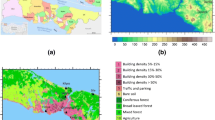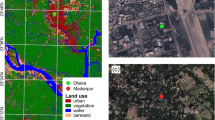Abstract
This paper describes the statistical characteristics and temporal variability of the urban heat island (UHI) intensity in Buenos Aires using 32-year surface meteorological data with 1-h time intervals. Seasonal analyses show that the UHI intensity is strongest during summer months and an “inverse” effect is found frequently during the afternoon hours of the same season. During winter, the UHI effect is in the minimal. The interannual trend and the seasonal variation of the UHI for the main synoptic hours for a longer record of 48 years are studied and associated to changes in meteorological factors as low-level circulation and cloud amount. Despite the population growth, it was found a negative trend in the nocturnal UHI intensity that could be explained by a decline of near clear-sky conditions, a negative trend in the calm frequencies and an increase in wind speed. Urban to rural temperature differences and rural temperatures are negatively correlated for diurnal and nocturnal hours both for annual and seasonal scales. This result is due to the lower interannual variability of urban temperatures in comparison to rural ones.

















Similar content being viewed by others
References
Alonso MS, Fidalgo MR, Labajo JL (2007) The urban heat island in Salamanca (Spain) and its relationship to meteorological parameters. Clim Res 34:39–46
Arnfield AJ (2003) Two decades of urban climate research: a review of turbulence, exchanges of energy and water, and the urban heat island. Int J Climatol 23:1–26
Barros VR, Camilloni IA (1994) Urban-biased trends in Buenos Aires’ mean temperature. Clim Res 4:33–45
Bejarán RA, Camilloni IA (2003) Objective method for classifying air masses: an application to the analysis of Buenos Aires’ (Argentina) urban heat island intensity. Theor Appl Climatol 74:93–103
Camilloni IA (1999) Temporal variability of the Buenos Aires’ urban heat island intensity. In: International conference on urban climatology ICUC’99, Sydney, Australia.
Camilloni IA, Barros VR (1997) On the urban heat island effect dependence on temperature trends. Clim Change 37:665–681
Comrie AC (2000) Mapping a wind-modified urban heat island in Tucson, Arizona (with comments on integrating research and undergraduate learning). Bull Amer Meteor Soc 81:2417–2431
Di Luca A, Camilloni IA, Barros VR (2006) Sea-level pressure patterns in South America and the adjacent oceans in the IPCC AR4 Models. Preprints of 8th International Conference on Southern Hemisphere Meteorology & Oceanogrphy. Foz de Iguazu, Brasil
Eliasson I (1996) Intra-urban nocturnal temperature differences: a multivariate approach. Clim Res 7:21–30
Figuerola PI, Mazzeo NA (1998) Urban–rural temperature differences in Buenos Aires. Int J Climatol 18:1709–1723
Fujibe F (2009) Detection of urban warming in recent temperature trends in Japan. Int J Climatol 29:1811–1822
Gaffin SR, Rosenzweig C, Khanbilvardi R, Parshall L, Mahani S, Glickman H, Goldberg R, Blake R, Slosberg RB, Hillel D (2008) Variations in New York city’s urban heat island strength over time and space. Theor Appl Climatol 94:1–11
Hoel P (1971) Introduction to mathematical statistics. Wiley, New York, 409 pp
Karl TR, Diaz HF, Kukla G (1988) Urbanization: its detection and effect in the United States climate record. J Climatol 1:1099–1123
Kidder S, Essenwanger OM (1995) The effect of clouds and wind on the difference in nocturnal cooling rates between urban and rural areas. J Appl Meteorol 34:2440–2448
Kim YH, Baik JJ (2002) Maximum urban heat island intensity in Seoul. J Appl Meteorol 41:651–659
Landsberg H (1981) The Urban Climate. Academic, New York, 275 pp
Lowry WP (1977) Empirical estimation of urban effects on climate: a problem analysis. J Appl Meteorol 16:129–135
Martínez A, Yagüe C, Zurita E (1991) Statistical analysis of the Madrid urban heat island. Atmos Environ 25:327–332
Mihalakakou G, Flocas HA, Santamouris M, Helmis CG (2002) Application of neural networks to the simulation of the heat island over Athens, Greece, using synoptic types as a predictor. J Appl Meteorol 41:519–552
Morris CJG, Simmonds I, Plummer N (2001) Quantification of the influences of wind and cloud on the nocturnal urban heat island of a large city. J Appl Meteorol 40:169–182
Oke TR (1973) City size and the urban heat island. Atmos Environ 7:769–779
Oke TR (1976) The distinction between canopy and boundary layer urban heat islands. Atmosphere 14:268–277
Oke TR (1982) The energetic basis of the urban heat island. Q J R Meteorol Soc 108:1–24
Oke TR (1987) Boundary layer climates, 2nd edn. Routledge, London
Oke TR, Hannell FG (1970) The form of the urban heat island in Hamilton, Canada. WMO Tech Note 108:113–126
Peterson TC (2003) Assessment of urban versus rural in situ surface temperatures in the contiguous United States: no difference found. J Climatol 16:2841–2959
Rosenzweig C, Solecki WD, Parshall L, Chopping M, Pope G, Goldberg R (2005) Characterizing the urban heat island in current and future climates in New Jersey. Global Environ Change B Environ Hazards 6:51–62
Roth M (2002) Effects of cities on local climates. In: Proceedings of the workshop of the institute for global environment studies/Asia-Pacific network (IGES/APN) Mega-city Project Kitakyushu, Japan (CD-ROM)
Roth M (2007) Review of urban climate research in (sub)tropical regions. Int J Climatol 27:1859–1873
Runnalls KE, Oke TR (2000) Dynamics and controls of the near-surface heat island of Vancouver, British Columbia. Phys Geogr 21:283–304
Simionato C, Vera CS, Siegismund F (2005) Surface wind variability on seasonal and interannual scales over Río de la Plata. J Coast Res 21:770–783
Sundborg A (1950) Local climatological studies of the temperature conditions in an urban area. Tellus 2:222–232
UNFPA (2009) State of world population 2009. Facing a changing world: women, population and climate. United Nations Population Fund, New York, p 104
Acknowledgments
This research was supported by the University of Buenos Aires UBACYT-X033, Consejo Nacional de Investigaciones Científicas y Técnicas PIP2009-00444 and Agencia Nacional de Promoción Científica y Tecnológica PICT07-00400. The meteorological information used in the present study was provided by the Servicio Meteorológico Nacional. The authors are grateful to two anonymous reviewers who contributed to improve this manuscript and to Aníbal Carbajo for preparing Fig. 2.
Author information
Authors and Affiliations
Corresponding author
Appendix
Appendix
The linear correlation coefficient (R UHI, r ) between the yearly mean urban to rural temperature differences (UHI) and rural (r) temperature for N years can be expressed as
where σ UHI, r is the covariance between UHI and r, and σ UHI and σ r are the corresponding standard deviations. Considering that UHI is calculated as the difference between the annual mean urban (u) and rural (r) temperatures and \( \overline u \)and \( \overline r \)are the means of u i and r i with i = 1,……N, Eq. 3 becomes
so
and
Multiplying and dividing by σ u
The linear correlation coefficient (R u, r ) between the yearly mean urban and rural temperatures for N years can be expressed is
Thus, Eq. 9 becomes
Resulting in
Rights and permissions
About this article
Cite this article
Camilloni, I., Barrucand, M. Temporal variability of the Buenos Aires, Argentina, urban heat island. Theor Appl Climatol 107, 47–58 (2012). https://doi.org/10.1007/s00704-011-0459-z
Received:
Accepted:
Published:
Issue Date:
DOI: https://doi.org/10.1007/s00704-011-0459-z




